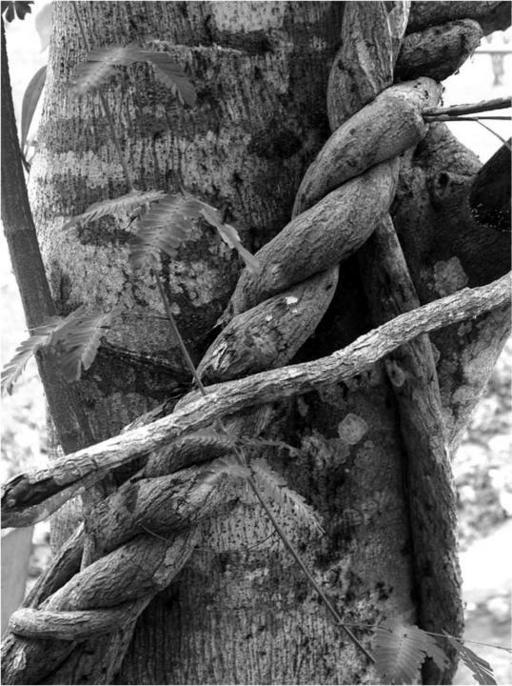Singing to the Plants: A Guide to Mestizo Shamanism in the Upper Amazon (2 page)
Read Singing to the Plants: A Guide to Mestizo Shamanism in the Upper Amazon Online
Authors: Stephan V. Beyer
Tags: #Politics & Social Sciences, #Social Sciences, #Religion & Spirituality, #Other Religions; Practices & Sacred Texts, #Tribal & Ethnic
CHAPTER 16
Magic Stones,
168
CHAPTER 17
Shamanic Herbalism,
172
CHAPTER 18
Plant Medicine,
176
CHAPTER 19
Types of Shaman,
196
PART
CHAPTER 20
An Introduction to Ayahuasca,
207
CHAPTER 21
Vomiting,
213
CHAPTER 22
Questions in the Study ofAyahuasca,
215
CHAPTER 23
Phenomenology of the Ayahuasca Experience,
229
CHAPTER 24
Mechanisms ofAyahuasca Hallucinations,
252
CHAPTER 25
Other Psychoactive Plants,
267
PART
CON'T'EX'T' AND SOURCES
CHAPTER 26
The Upper Amazon Culture Area,
281
CHAPTER 27
Being Mestizo,
293
CHAPTER 28
Beings of Earth and Water,
314
CHAPTER 29
Hispanic influences,
324
CHAPTER 30
Folk Catholicism,
330
PART IV
MEETING MODERNITY
CHAPTER 31
Ayahuasca Meets Global Modernism,
337
CHAPTER 32
Ayahuasca Tourism,
349
CHAPTER 33 AyahuascaandtheLaw,356
CHAPTER 34
Shamans Fight Back,
376
APPENDIX A Plants Mentioned in the Text,
387
APPENDIX B Animals Mentioned in the Text,
399
Notes
405
Index
517
This work has grown out of seven trips to the Amazon, first to study jungle survival and then, gradually, to become absorbed, both personally and academically, in Amazonian spirituality. I have had the great good fortune to have studied
with four mestizo shamans-don Antonio Barrera Banda, don Romulo Magin,
dona Maria Luisa Tuesta Flores, and don Roberto Acho Jurama. I am particularly
indebted to dona Maria and don Roberto, who generously answered my questions, guided my visions, worked on the ache in my knee, protected me from
sorcery, and taught me more than I have any right to know. Don Roberto is my
treasured maestro ayahuasquero.
My contacts with mestizo healers were arranged by my friend Howard
Lawler, a herpetologist by training and a longtime resident of the Amazon,
who has shared with me his remarkable ethnobotanical knowledge and has
been a cultural and linguistic translator, friend, confidant, generous resource,
trusted guide and adviser, and brother on the medicine path. He has generously shared with me his remarkable library of digital images of Amazonian
plants, and allowed me to reproduce those and other of his photographs in
this book. For all of that-as for so much else-I am forever in his debt.
I am grateful too to the kind people at the October Gallery in London, especially Danielle Nunez and its director Chili Hawes, who helped provide the
cover illustration painted by visionary artist don Francisco Montes Shuna. The
gallery is a leading pioneer of the transvangarde or transcultural avant-garde, a
sponsor of traditional and indigenous artists, and dedicated to the appreciation of cutting-edge contemporary art from cultures around the planet.
Of course, there is my large, boisterous, loving, warm, supportive, curious,
critical, outspoken family, who connect me to all things most deeply human,
bind me to the tragic and glorious cycles of life, and make me whole.
And this one, finally, is for Miriam. At last there is a neat symmetry between my books and my children, and Miriam's spirit goes together with my
newest adventure.
There are several reasons why a book on the mestizo shamanism of the Upper
Amazon is worth writing at this time. Mestizo shamanism occupies an exceptional place among the shamanisms of the Upper Amazon, assimilating key
features of indigenous shamanisms, and at the same time adapting and transforming them. There is today considerable interest in shamanism in general,
and in Upper Amazonian shamanism in particular, especially its use of plant
hallucinogens; yet there is currently no readily accessible text giving general
consideration to the unique features of Amazonian shamanism and its relationship to shamanisms elsewhere in the world.
Moreover, many key texts, such as Luis Eduardo Luna's 1986 dissertation,
are out of print and almost impossible to find; and many important studies
are in foreign languages, especially French, such as the work of Alfred Metraux and Jean-Pierre Chaumeil. The beautiful and informative book Ayahuasca Visions, the combined work of mestizo visionary artist Pablo Amaringo and
anthropologist Luis Eduardo Luna, is organized as a commentary on a series
of paintings and thus, despite an extensive index, is not well organized for
overall information. And much information, of course, is buried in specialist
ethnographies of Amazonian peoples intended for a professional rather than
general audience.
We now know much more about shamanism than when Mircea Eliade
published his famous overview in 1951. There is now a wider range of excellent ethnographies, including many of Amazonian peoples; debates within
the field have sharpened an awareness of many of the assumptions that underlay the fieldwork of many decades ago. Indeed, we now know, too, much
more about ethnobotany, hallucinations, and the actions of such substances
as dimethyltryptamine. It is time to try to put some of this together.
There was a time when I was deeply interested in wilderness survival. I was
filled with machismo; drop me in the desert naked with a knife, I said, and
I will eat lizards and survive. I undertook training in mountain, desert, and
especially jungle survival, which took me on a number of trips to the Upper Amazon, both for training and to study indigenous survival techniques. One
of these trips, with wilderness survival expert Ron Hood, to study the jungle
survival skills of the last of the head-hunting Shapra and Candoshi Indians,
became an award-winning survival training film.,

FIGURE i. The ayahuasca vine.
But, as I learned more and more about the ways in which indigenous people survive-indeed, flourish-in the wilderness, it became increasingly clear to me that wilderness survival includes a significant spiritual component-the
maintenance of right relationships both with human persons and with the
other-than-human persons who fill the indigenous world. Thus I began to explore wilderness spirituality, to learn ways to live in harmony with the natural
world, striving, like indigenous people, to be in right relationship with the
plant and animal spirits of the wilderness. I undertook numerous four-day
and four-night solo vision fasts in Death Valley, the Pecos Wilderness, and the
Gila Wilderness ofNew Mexico. I began to work with ayahuasca and other sacred plants in the Upper Amazon, peyote in ceremonies of the Native American Church, and huachuma in Andean mesa rituals.
So, too, this book is a result of my own need to make sense of the mestizo
shamanism of the Upper Amazon, to place it in context, to understand why
and how it works, to think through what it means, and what it has meant for
me.
Here is a story. I am drinking ayahuasca. Suddenly I find myself standing
in the entry hallway of a large house in the suburbs, facing the front door. The
floor of the hallway is tiled, like many places in the ayahuasca world. There
is a large staircase behind me, leading to the second floor; there are large ceramic pots on either side of the entrance way. I open the front door and look
out at a typical suburban street-cars parked at the curb, traffic going by, a
front lawn, trees along the curb. Standing at the door is a dark woman, perhaps in her forties, her raven hair piled on her head, thin and elegant, beautiful, dressed in a red shift with a black diamond pattern. She silently holds out
her right hand to me. On her hand is a white cylinder, about three inches long,
part of the stem of a plant, which she is offering to me.
I was concerned about this vision, because the red and black dress might
indicate that the dark woman was a bruja, a sorceress. But don Roberto, my
maestro ayahuasquero, and doh a Maria, my plant teacher, both immediately
and unhesitatingly identified her as maricahua, whom they also call toe negro,
the black datura. They told me that this plant is ingested by splitting the stem
and eating a piece of the white inner pith, about three inches long. The lady
in my vision was handing me just such a piece of the plant, a part of herself.
Ayahuasca teaches many things-what is wrong or broken in a life, what
medicine to take for healing. It teaches us to see through the everyday, to see
that the world is meaningful and magical; it opens the door to wonder and
surprise. I need to open my front door, look out onto a bland suburban street,
and see standing there the Dark Lady, the black datura-thin and dark, raven
hair piled on her head, elegant and beautiful, silently holding out to me a stem
of maricahua-and follow her into her dark and luminous world.
